TL;DR
Short on space but long on an awkward cutout? The best uses for a bedroom alcove are vanity, built‑in shelves, closet conversion, reading nook, or a beverage/coffee bar. For anyone asking what to do with an awkward bedroom nook, aim for shallow elements (10–12 in. shelves, 18–21 in. bench depth) and good lighting. If storage is the priority, learn how to convert an alcove into a closet with doors or a tension‑rod curtain in a weekend.
Yes, You Can Love That Odd Bedroom Cutout

Knowing typical alcove proportions helps you design intentional, functional spaces for seating, storage, or display.
Got a weird bedroom alcove or cutout? Here are practical, stylish ways to make it work — vanity, reading nook, closet, coffee bar, and more.
Here’s the thing: a bedroom alcove is usually 28–48 inches wide and 18–30 inches deep, which is perfect for built‑in shelves, a small vanity, or a mini library. Designers often advise choosing a single primary function and sizing elements with strict dimensions — 10–12 inch shelves for books, a 24 inch deep clothes rod for a closet, and 18–21 inch bench depth for seating — so the space looks intentional, not improvised.
I’ve seen homeowners transform notches between mirrored closets into makeup vanities because there’s already an outlet; others add U‑shaped shelving for linen storage, or a tension rod and curtain to create a quick closet. If you match lighting color temperature and trim the opening with paint or molding, the nook becomes a feature, not a compromise.
The Best Uses for a Bedroom Alcove (and How to Build Them)
The highest‑value uses for a bedroom alcove maximize vertical storage, maintain 30–36 inches of clear passage, and add task lighting at the point of use.
1) Vanity or get‑ready zone
Fit a 24–30 in. wide floating top at 29–30 in. high, add a 24 in. round or arched mirror, and mount sconces at 60–66 in. above the floor. A plug already in the niche makes this a fast win.
2) Built‑in shelves or mini library
Use 10–12 in. deep shelves for books; 12–16 in. if you want baskets. Space shelves 10–12 in. apart and add a low backlight or LED strip for a glow that doubles as a nightlight.
3) Closet conversion
Install a 24 in. deep hanging rod (18 in. minimum for narrow hangers), plus a top shelf. For a finished look, add a door, bifolds, or a ceiling‑mounted curtain track and full‑length drapery.
4) Reading nook
An 18–21 in. deep bench cushion or a slim lounge chair, a small side table, and a wall sconce do the trick. Keep arm clearance of 2–3 in. on each side so seating doesn’t scuff walls.
5) Beverage station or coffee bar
A 24 in. countertop with a drawer stack beneath and space for a mini fridge creates a boutique‑hotel feel. Provide a GFCI outlet and ensure 2–4 in. ventilation space around appliances.
6) Linen tower or utility storage
U‑shape shelves maximize volume: 14–16 in. deep for bulky duvets and bins. Label shelves by bed size so sets stay paired.
7) Plant niche
Layer a tall plant (fiddle leaf, strelitzia) with a 3000–3500K spotlight; add a drip tray and felt feet to protect floors. If light is low, integrate a discreet grow light on a timer.
8) Pet suite or concealed litter area
Ventilate with a small, quiet fan if enclosed, and use a washable mat. A cabinet with a side cutout hides the box while containing scatter.
9) Display niche for art or collectibles
Install a picture light centered at 58–60 in. to highlight a statement piece. Shallow glass shelves (8–10 in.) keep objects visible without crowding.
10) Mirror try‑on corner
Mount a full‑length mirror on the back wall and add two side hooks for hats or “clothes‑purgatory” items. A 2700–3000K sconce from above gives flattering, even light.
11) Charging and tech valet
Run a surge‑protected power strip to a drawer with a cable grommet. Dedicated spots for headphones, e‑readers, and watches tame visual clutter.
12) Hidden storage with a faux bookcase door
If you crave secrecy, a shallow cabinet or bookcase door can turn the opening into concealed storage. Check that added doors don’t block closet sliders nearby.
User insight: People love the “clothes‑purgatory” rack here — a single rod plus two shelves keeps worn‑again items off the bed and chair.
Anecdote
One couple kept a chair jammed into a 32 in. niche for years. Swapping it for 10 in. shelves and a picture light freed the walk path and made their favorite books the room’s focal point — they started reading in bed again instead of doom‑scrolling.
Common Mistakes People Make With Bedroom Alcoves
Most awkward‑nook fails come from depth errors, dim light, or cramming in too many ideas at once.
- Going too deep with shelves. Over 12–14 in. for books makes them vanish into shadow. Fix it with 10–12 in. shelves and front‑edge lighting.
- Ignoring electrical and ventilation. Mini fridges and espresso machines need dedicated outlets and 2–4 in. air gap. Avoid heat‑trapping cabinets.
- Skipping a focal point. A niche needs an anchor — a mirror, art, or centered shelf stack — or it reads like leftover space.
- Mismatched color temperatures. Keep bulbs at 2700–3000K in bedrooms for consistent warmth. Designers often advise matching lumens across fixtures for an even look.
- Assuming it must be seating. If the width is under 30 in., seats feel cramped. Choose vertical storage or a standing vanity instead.
Pro Tips Designers Swear By
The fastest way to make a bedroom alcove look custom is to treat the opening like architecture: trim, paint, lighting, then function.
- Frame it. Add 2–3 in. casing or a painted border one shade deeper or lighter than the wall to define the niche.
- Layer light. Combine a sconce or picture light with hidden LED tape under a shelf for task and ambient light. Dimmer switches give control for day and night.
- Float when you can. Floating vanities and shelves keep baseboards continuous and floors easy to clean; aim for 10–12 in. between shelves.
- Plan for power. If adding outlets, many jurisdictions require AFCI/GFCI protection in bedrooms; consult a licensed electrician.
- Test the footprint. Tape out the plan and live with it for 24 hours. If you can’t stand comfortably or open adjacent doors, scale down.
- Upgrade hardware. A single elegant pull, a slim brass picture light, or a marble threshold can elevate even budget builds.
Reflection: The best niche I ever saw used a $30 curtain track and linen panel — that one soft line turned “random cutout” into “intentional dressing room.”
Real Rooms, Real Fixes — And a Few Tools to Help
Real solutions prove the point: a small, well‑planned change can reshape daily routines.
- The vanity that kept peace. A renter mounted a 28 in. shelf, plug‑in sconces, and a round mirror; makeup moved out of the tiny bath, and mornings stopped colliding.
- The library that tucks you in. A narrow alcove became 10 in. shelves with a reading sconce; a velvet stool slides under, keeping the walkway clear.
- The “closet you didn’t know you had.” Tension rod, blackout‑lined curtain, and two stackable shoe racks turned a visual gap into a hidden wardrobe wall.
- The hotel‑at‑home bar. A butcher‑block top, drawer unit, and a quiet mini fridge created a coffee station; a tray corrals mugs and a kettle for tidy ritual.
Helpful tools and inspiration
- Painter’s tape for layouts, stud finder, dimmable LED strips, plug‑in sconces, curtain track systems.
- Planning apps like ReimagineHome to visualize a vanity, closet, or library in your exact niche before you commit.
- Image ideas (alt text): “Bedroom alcove turned into built‑in vanity with arched mirror and brass sconce,” “U‑shaped linen shelves inside small bedroom nook,” “Cozy reading nook with slim bench cushion and wall light.”
Visualization Scenario
Picture this: soft green walls, an arched brass mirror glinting under a 3000K sconce, a slim floating shelf at desk height, and a linen curtain you can sweep closed before bed. The niche glows like a private stage set — sized to you, not a catalog.
FAQ: Your Most‑Searched Bedroom Alcove Questions, Answered
- How should I use a weird bedroom alcove?
The simplest, high‑impact options are a vanity, built‑in shelves, closet conversion, or a reading nook. Designers often advise choosing one function and sizing pieces to standard depths: 10–12 in. shelves, 18–21 in. bench depth, 24 in. hanging depth. - What’s the best way to turn a bedroom alcove into a closet?
Install a 24 in. deep rod with a top shelf and close it with a door or ceiling‑mounted curtain. For a quick fix, a tension rod and full‑length drapery create a neat, flexible closet. - How do you create a reading nook in a small bedroom alcove?
Use a slim bench cushion or compact chair, add a wall sconce at 60–66 in. high, and keep shelves to 10–12 in. deep. Warm 2700–3000K bulbs make the nook cozy and flattering. - Can I put a mini fridge or coffee bar in a bedroom alcove?
Yes, but provide a GFCI outlet and 2–4 in. ventilation space around the appliance. A 24 in. countertop with a drawer stack keeps supplies organized and quiet. - What size vanity fits in a narrow alcove?
Aim for a 24–30 in. wide, 29–30 in. high surface with a 24 in. mirror and sconces centered at about 64 in. to eye level. A backless stool that tucks under saves precious inches.
Make the Nook Earn Its Keep
A weird bedroom alcove becomes a win when you match one clear purpose to careful dimensions, add warm lighting, and finish the opening like architecture. Start with a single move — a shelf, a mirror, or a curtain — and let the niche earn its keep day after day.
Want to see three versions before you build? Drop a photo into ReimagineHome and test a vanity, library, or closet layout in minutes.
.svg)

.svg)
.jpg)

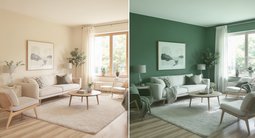
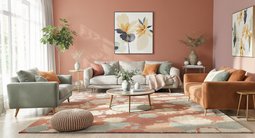
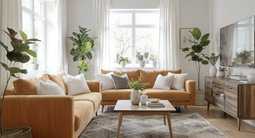

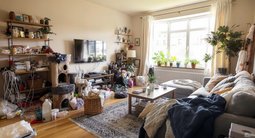
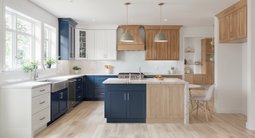
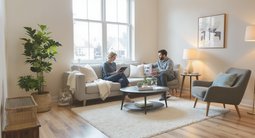
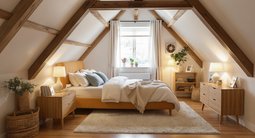



.png)